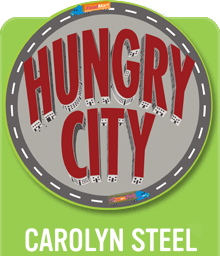Posted by Carolyn on September 8, 2011 at 3:06 pm
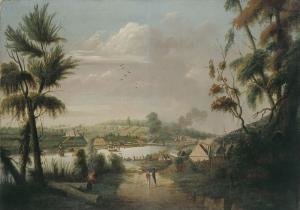
Last month I was delighted to make my first trip to Australia as the guest of the Melbourne State of Design Festival. Australia faces unique problems when it comes to feeing itself; not just because so much of it is desert. Having missed out on the last Ice Age, it is an ‘old’ landscape, which means that, even in its most fertile region (the South Eastern corner where Sydney, Melbourne and Adelaide are located) its soils are thin compared to those at similar latitudes in Europe.
This posed terrible problems for British settlers, who were at pains to discover which parts of the coast, if any, would be capable of sustaining their colonies. As I discovered during my research of the sitopian development of Sydney and Melbourne, both cities were second attemps to find fertile ground, the colonists having rejected their initial attempts to find suitable sites.
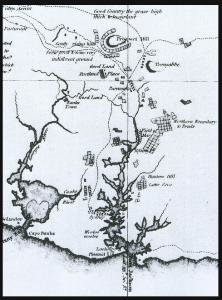
As the map above shows, Sydney Cove was favoured since it led to good grazing ground inland, essential to the colonists’ abilty to supplement their stocks of food imported from home. Early prints of Sydney also show the market gardens established around Government House, and windmills on the hill behind.
I found it fasinating to trace the settlers’ thoughts and actions as they founded their colonies; identical, one imagines, to those of ancient Greeks and Romans as they sought to expand their empires and find new means of survival.
Posted by Carolyn on July 11, 2011 at 11:20 pm
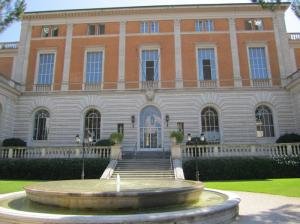
The American Academy in Rome is one of those buildings you take a deep gulp before entering. Built on top of one of Rome’s famous hills with incredible views over the city, it has the sort of imposing air designed to shock and awe. Thankfully, its residents are delightful, welcoming souls, one of whom, Fritz Haeg, kindly invited me there last week to speak about Food and Rome. It is a subject close to my heart, since, when I was at the British School at Rome, I had studied an area of the city around the Theatre of Marcellus, the site of the ancient Roman food markets, as well as the S.Angelo fish market, Rome’s main purveyor of pescine products for nine hundred years.
Putting my lecture together made me realise how little about food and cities really changes. For instance, fish in the medieval city could only be sold from slabs in the S.Angelo Market, which made ownership of one extremely lucrative: the slabs were worth more than a house; and were, needless to say, owned by noble families, not by the fishmongers who sold from them:
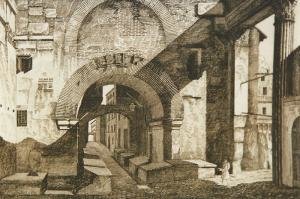
Equally impressive is Monte Testaccio, Rome’s ‘Eighth Hill’, which is made up of all the shattered amphorae that once brought food to the city. There could be no greater monument to the extraordinary effort it took to feed Rome, than that its waste packaging should still constitute a significant piece of geography two millennia later:
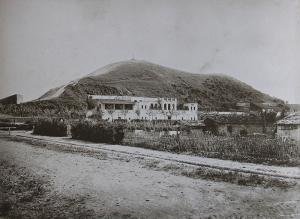
Fritz, by the way, is currently working on a wonderful project called Roma Mangia Roma, interviewing five generations of Romans about their food stories, the subject of a forthcoming book. You can find out more about his project here:
Roma Mangia Roma
Posted by Carolyn on May 7, 2011 at 3:26 pm

Since power and profit in food lie entirely in the exchange between producer and consumer, I am always on the lookout for interesting new food network models. I was delighted, therefore, to be invited to visit Flanders recently, where a scheme called ‘Voedselteams’, or Foodteams, has been operating with great success for the past ten years.
The scheme works like this: a group of households in one neighbourhood (usually between 10-20 in number) decide to set up a Foodteam. They then register on the Foodteams website, where they can choose from a list of local organic producers of fruit and vegetables, meat, dairy, bread, and even wine. The food is ordered online, and the producers deliver once a week to a variety of locations, including members’ garages (as in the photo above), community kitchens, medical centres and so on. Members then take it turns to sort out the deliveries and organise the pick-ups, which typically take place in a two-hour weekly evening slot. Members and producers meet once a year, to review the scheme and discuss their approach for the following year.
Membership costs just €10 per year, for which members not only get to eat tasty, local, seasonal and ethical food, but learn more about their food too. They forge links with their farmers, who often send notes with their produce, with background information, hints and recipes. Members also get to know one another through the scheme, and many now socialise outside the Foodteam context. With 70 producers supplying 90 Foodteams in Flanders, the success of the scheme is evident, and there are plans to extend it to the rest of Belgium, and indeed further afield.
For more information, visit the Foodteams Website:
Voedselteams
Posted by Carolyn on May 5, 2011 at 1:35 pm

As regular readers of this irregular blog will know, one of the highlights of my post-HC career was to speak at TEDGlobal in 2009. This was a truly inspiring, although terrifying event, and I have often had occasion to be grateful for the experience, not just for the amazing boost of positive energy that it gave me, but because, after TED, I felt that no speaking event could ever be scary again.
It was interesting, therefore, to be invited to speak at TEDxDanubia recently, which took place in a stunning theatre in Budapest, the ceiling of which you can see at the head of this post. I was curious to see whether TED2 would awaken the same sense of terror that TED1 had done, and, right up to the wire, I felt absolutely fine. It was only on stepping in front of 400 eager Hungarians that I realised that, yes, I had the TED nerves all over again. Talking about a subject you are passionate about is one thing; doing it to a strict time schedule is quite another. In any case, it seemed to go OK, and it was great to have the chance to share some of my latest thinking about sitopia, and how we can use food as a tool. You can see my talk, if you like, here:
Carolyn’s TEDxDanubia talk
Posted by Carolyn on April 9, 2011 at 11:33 am
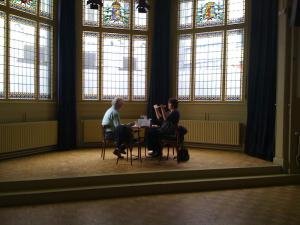
The launch of De Hongerige Stad was exhausting; I don’t think I have ever done as much talking over a three-day period! But it was worth it. I had some wonderful conversations with Dutch journalists, whom I found to be remarkably clued up about issues surrounding food. I was given this wonderful room in De Balie, a famous debating hall in Amsterdam, for the day; it was a great space in which to talk and think! In fact it was sitting at this table, trying to answer a particularly knotty question, that I realised that I am going to have to write another book.
My Dutch publishers Nai have kindly had some of my interviews translated into English, and here they are:
volkskrant-29-march-2011.doc
nrc-24-march-2011.doc
trouw-21-march-2011.doc
hp-de-tijd-4-march-2011.doc
Posted by Carolyn on March 22, 2011 at 11:12 am
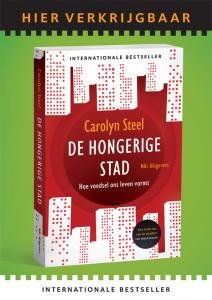
Hungry City is now out in Dutch! Published by Nai Publishers, De Hongerige Stad is the first translation of HC into a European language – an interesting experience for me, since I was locked in lengthy debates with the (wonderful and pernickety) translators Leo Reijnen and Wouter Groothuis for many weeks over the precise meaning of certain expressions….even between English and Dutch, it seems, a lot can get lost in translation. I was amazed to discover, for instance, that there is no word in Dutch for ’squeamish’. What this suggests about Dutch and British attitudes to food is fascinating in itself.
Posted by Carolyn on October 28, 2010 at 8:39 am
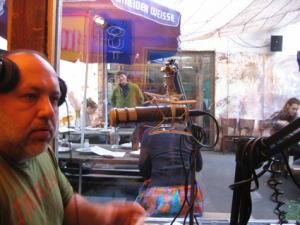
I’m just back from New York, which is fast becoming the ‘new food movement’ capital of the west. More about that soon, but first, among my many extraordinary experiences in an action-packed week, the most surreal: my unexpected appearance on Heritage Radio, a wonderful foodie channel set up by Patrick Martins, founder of Slow Food USA. The station is housed in a shipping container in the garden of Roberta’s pizzeria (see below), purveyors of some of the most delicious pizzas I have ever eaten, the ingredients for which are grown by Ben Flanner on Brooklyn Grange farm, one the city’s growing number of rooftop farms (see what I mean??).
The show was Beer Sessions, hosted by bar owner and restaurateur Jimmy Carbone, an New York-Italian bundle of Falstaffian energy and bonhomie (that’s him at the top). Jimmy is a legend amongst New York foodies, and his side room at No.43 (on East 7th Street) is a nexus of every kind of foodie activity, including, last December, the New York version of ‘Dirt Cafe Sitopia’.
Jimmy is also very serious about good beer, so when he invited me onto his show, I was somewhat nervous, having what can only be described as a patchy knowledge on the subject. My feelings intensified as I sat listening to detailed discussions about, amongst other things, the properties of artisanal beers and the problems inherent in managing seventy ‘lines’ in one bar, but I needn’t have worried. Jimmy is a great host, and somehow got me talking about London brewers and pubs, hops and taverns – and Samuel Pepys – as if I had thought of nothing else all my life. In fact, the whole thing was a hoot. Thanks, Jimmy!
If you want to hear my ramblings, and learn quite a bit about beer, click Beer Sessions“>here:
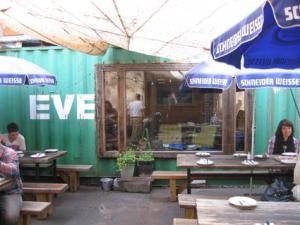
Posted by Carolyn on October 14, 2010 at 2:47 pm
What are sitopian economics? I am no economist, so I can’t answer that question precisely. However, if we are to create a better, more equable and sustainable way of life by thinking through food (ie create sitopia) then clearly we are going to need different economic models to those we have at present. Sitopia is about understanding the true value of food and what it represents, so nothing could be more central to its cause. I am therefore always keen to ask economists how they think economics might be changed in order to create a more sitopian world. This usually leads to a lively discussion, from which I emerge with some fuzzy ideas, but nothing concrete. Imagine my delight, therefore, when Niels Peter Hahnemann responded to my challenge by writing his own sitopian economic vision. Niels Peter is married to the famous Danish chef Trine Hahnemann, so theirs is a sitopian family, and I must say that his piece, attached here, captures the essence of sitopia beautifully, and is the most eloquent description of how the messy, shared exchanges of food might translate into a new economic reality that I have read. Niels Peter: thank you!
sitopian-vision-hahnemann.pdf
Posted by Carolyn on October 11, 2010 at 6:13 pm
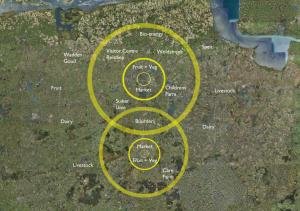
My current work is focused on sitopia, or food-place: the idea that we can use food as a tool to rethink how we live, as discussed in the final chapter of Hungry City. I am doing this in various ways, one of the most exciting of which is my collaboration with the northern Dutch city of Groningen, with whom I am developing a ‘Regional Food Vision’. The vision is a way of rethinking the city and its region through food, to reconnect city and country, and create new social and physical networks for a better and more sustainable future. We launched the initiative two weeks ago, and there has already been considerable interest. I am thrilled to be working with Groningen, and will keep you posted as our vision develops.
Posted by Carolyn on September 3, 2010 at 2:18 pm

I am delighted to say that Hungry City is now available in Chinese. It is published by the China Renmin University Press. I would love to hear from anyone who has read it in Chinese, and what they think of it!
